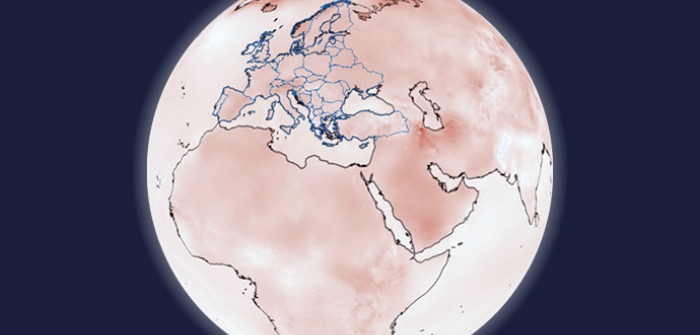The EU-funded Copernicus Climate Change Service (C3S), implemented by ECMWF, has launched two tools – Copernicus Interactive Climate Atlas and Climate Pulse – to make it easier for users to explore how the climate has been changing and how it could change in the future.
Interactive Climate Atlas
The Copernicus Interactive Climate Atlas is a new tool that enables the visualization and exploration of a variety of past, present and future climate data. It builds on the Interactive Atlas of the Intergovernmental Panel on Climate Change (IPCC-IA).
The tool includes data from a variety of sources, such as ECMWF’s ERA5 climate reanalysis and ORAS5 global ocean reanalysis, the World Climate Research Programme’s CMIP5 and CMIP6 data sets, and others.
As well as visualizing global data, users can choose which regions to call up for information, and they can study data for different periods. There are also visualizations for dozens of variables, including, for example, mean temperature, frost days, sea-ice area, mean wind speed and cloud cover.
“This Atlas is an interface to access the data we have. It can be used by national meteorological services and climate centers as well as policymakers, businesses and the general public,” said Carlo Buontempo, the director of C3S.
Climate Pulse
C3S has also developed a download and visualization tool for current and historical data, intended mainly for the media. Called Climate Pulse, it enables journalists and others to easily download the latest information for air temperature and sea temperature.
ERA5 data is made available for different timeframes and in different visualizations. “This interactive web application is currently in its beta release, and C3S is keen to further improve it,” Buontempo said.
Unprecedented heat
The Atlas and Climate Pulse updates come at a time when C3S has found global surface air temperatures to be the warmest on record over the last 12 months. The global average temperature from March 2023 to February 2024 was 0.68°C above the 1991–2020 average and 1.56°C above the 1850–1900 pre-industrial average. July 2023 was the warmest month on record. February 2024 was the warmest February on record, and the daily global temperature reached 2°C above 1850-1900 levels on four consecutive days (February 8–11).
What next for C3S?
C3S aims to continuously develop its products to provide the best possible service. This includes the development of a new climate reanalysis, ERA6, which is expected to replace ERA5 in 2027.
ERA6 will approximately halve the grid spacing of ERA5, from close to 30km to close to 15km. It will also be more directly coupled with the ocean than ERA5. “We know that this is important for a large class of phenomena, such as tropical cyclones and ocean heatwaves,” said Buontempo.
ERA6 will be using the latest advances in Earth system modeling and data assimilation made by ECMWF. It will also benefit from efforts to make more observations available. “C3S has worked with EUMETSAT and other organizations to reprocess old data and to rescue data that would otherwise be lost,” Buontempo said. “This will enable ERA6 to rely on an array of historical data that is as wide as possible.”
C3S aims to provide policymakers, businesses and the general public with climate change information that is useful to them. The next milestone in its development will be the introduction of the new higher-resolution climate reanalysis, ERA6, which is expected to replace ERA5 in 2027.
In related news, ECMWF has recently released a much larger open data set to the public, representing weather forecasts at a higher resolution and with a reduction in release times. Click here to read the full story.



